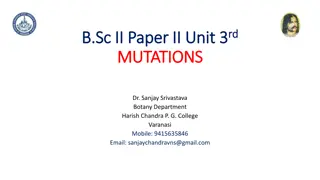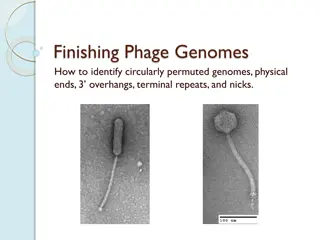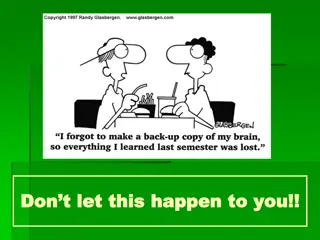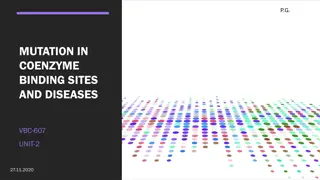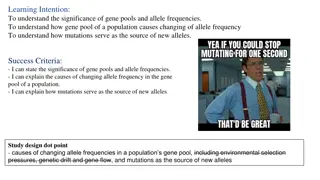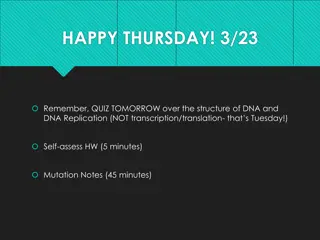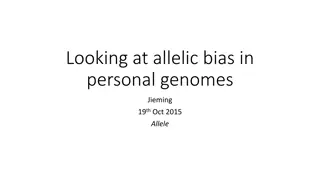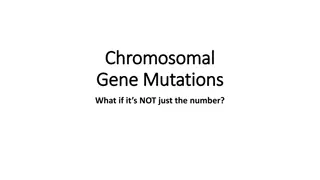Understanding Mutations and Natural Selection in Genomes
Explore how mutations impact survival and how genomes record these changes, distinguishing between functional and nonfunctional sequences. Learn about the effects of mutations on organism survival and the role of natural selection in shaping genetic variability.
Download Presentation

Please find below an Image/Link to download the presentation.
The content on the website is provided AS IS for your information and personal use only. It may not be sold, licensed, or shared on other websites without obtaining consent from the author. Download presentation by click this link. If you encounter any issues during the download, it is possible that the publisher has removed the file from their server.
E N D
Presentation Transcript
Mutation And Natural Selection how genomes record a history of mutations and their effects on survival Tina Hubler, Ph.D., University of North Alabama, Florence AL
Gene Organization Coding sequences are used during transcription to make RNAs that are translated into protein or RNAs that have a function (e.g. tRNA, rRNA, snRNA, microRNA). Coding sequences code for the production of a molecule. Includes exons of genes. Noncoding sequences are not used as a code for production of a molecule. Includes promoters, introns, 5 and 3 untranslated regions and intergenic regions. They may have regulatory functions such as controlling gene expression or the half life of RNA. Many are presumed to have no function until a function is determined experimentally.
Gene Organization Gene Intergenic region Gene Promoter 5 UTR Exon Intron Exon Intron Exon 3 UTR
DNA sequence classification Functional sequences Nonfunctional sequences Coding sequences Promoters Other regulatory regions some 5 UTRs some 3 UTRs some introns some intergenic regions Some 5 UTRs Some 3 UTRs Some intronic regions Most intergenic regions Pseudogenes
Mutations Occur every time DNA is replicated before cell division. Occur throughout the genome in BOTH nonfunctional and functional sequences. May be neutral, harmful or beneficial. The following slides will use this color scheme: Organism with mutation in nonfunctional region Organism with beneficial mutation in functional region Organism with neutral mutation in functional region Organism with harmful mutation in functional region
Selection, nonfunctional sequences Mutations in nonfunctional sequences have no effect and organisms survive to pass mutated sequences on to offspring. So all mutations may be considered neutral . Different shades of blue indicate additional accumulated mutations in nonfunctional regions as generations progress, resulting in highly variable sequences. I have 1 mutation I have 2 mutations I have 1 mutation I have 1 mutation I have 2 mutations I have 3 mutations I have 4 mutations
Selection, functional sequences (neutral mutations) Mutations in functional sequences may be neutral, benefical or harmful. Neutral mutations have no effect (e.g. change one nucleotide and do not change the amino acids of a protein), therefore organisms survive to pass neutral mutations on to offspring. Different shades of burgundy/pink indicate additional accumulated neutral mutations, resulting in variable sequences that are often single nucleotide changes. Functional sequences may also acquire harmful (red) or beneficial (green) mutations that affect organisms survival, so the chances of acquiring accumulated neutral mutations is less than for nonfunctional sequences. I have 1 neutral mutation I have 2 neutral mutations I have 1 neutral mutation I have 1 beneficial mutation I have 1 neutral mutation I have 1 harmful mutation I have 2 neutral mutations
Selection, functional sequences (harmful mutations) Mutations in functional sequences may be neutral, benefical or harmful. Harmful mutations have a negative effect (e.g. change one nucleotide that negatively impacts the structure and function of a protein). Organisms suffer and are less likely to survive to pass the mutations on to offspring. Therefore, harmful mutations often disappear from population gene pools. I have 1 harmful mutation X No offspring
Selection, functional sequences (beneficial mutations) Mutations in functional sequences may be neutral, benefical or harmful. Benefical mutations have an advantageous effect (e.g. change one nucleotide and improve the structure and function of a protein). Organisms are more likely to survive, reproduce and pass this mutation to offspring. The same shade of green indicates a conserved sequence. Different shades of green indicate additional accumulated mutations that are not harmful. I have 1 beneficial mutation We all have the same beneficial mutation
!!! Summary !!! Mutation location and type Effect Historical Record in Genome Nonfunctional sequence none highly variable sequences Functional sequence neutral none moderately variable sequences harmful deleterious rarely observed in the genomes of surviving organisms beneficial advantageous sequences conserved from generation to generation
The effect of selection on the number of surviving organisms carrying harmful (clear), neutral (grey) or beneficial (black) mutations Harmful Mutations Neutral Mutations Beneficial Mutations One Generation Many Generations Few Or None



